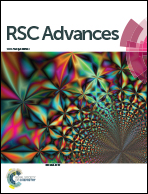Catalytic dehydrogenation of isobutane over Co-based catalysts†
Abstract
In this work, to optimize the catalytic performance of Co-based catalysts for isobutane dehydrogenation, the effects of support, calcination temperature and some promoters were investigated systematically. Results of activity tests and catalyst characterization jointly indicated that both the support and calcination temperature influenced Co dispersion, catalyst acid properties and the interaction between support and Co species significantly. Consequently, the adsorption–desorption behaviors for isobutane and isobutene as well as the dehydrogenation performance were further affected. Sulfided Co/SiO2, with no acidity, exhibited the best performance. Although high calcination temperature was beneficial for achieving a high selectivity to isobutene over Al2O3 and MgAl2O4 supported Co-based catalysts, the inevitable formation of Co2SiO4 over Co/SiO2 at high temperature led to reduced active sites and dehydrogenation activity. In addition, by comparing the different effects of the separate introduction of S, Sn, Cu and Cl, it was concluded that an efficient promoter should present the following characteristics: inhibition of the formation of metal ensembles, and strong binding affinity to two hydrogen atoms of one additive atom.


 Please wait while we load your content...
Please wait while we load your content...